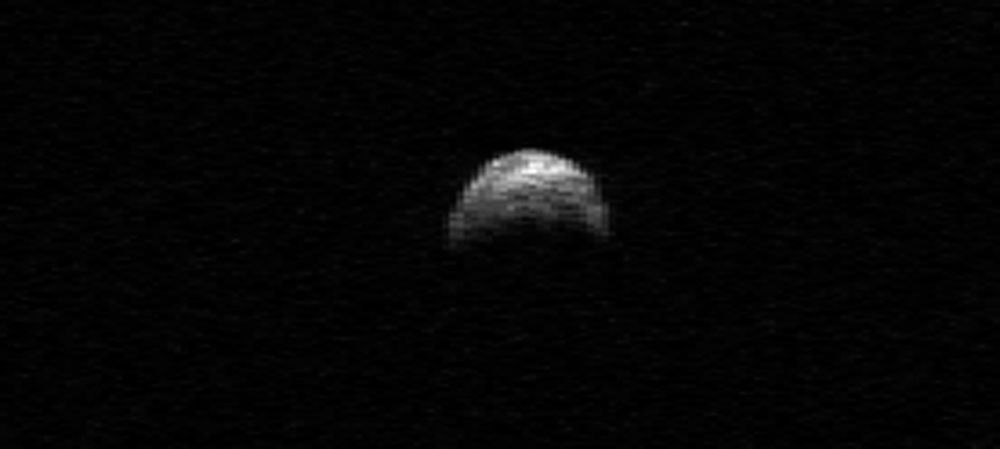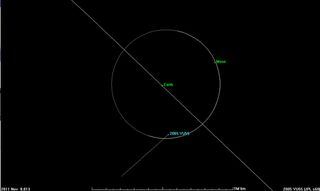
Next week, an asteroid the size of an aircraft carrier will zip by Earth inside the orbit of the moon, marking the closest pass by such a big space rock in 35 years.
The near-Earth asteroid, which is called 2005 YU55, will make its closest approach at 6:28 p.m. EDT (2228 GMT) on Nov. 8. But astronomers will start their concerted observation campaign even earlier, training a battery of instruments on 2005 YU55 beginning this Friday (Nov. 4) to learn as much as possible about the asteroid before it recedes into deep space once again.
Here are the basics about 2005 YU55's upcoming flyby of Earth, which astronomers are anticipating with scientific curiosity, not existential dread.
How big is 2005 YU55?
The asteroid, which was discovered in December 2005, is about 1,300 feet (400 meters) wide, making it about as big as an aircraft carrier. It makes one lap around the sun once every 15 months or so. [Photos: Asteroids in Deep Space]
The last time a space rock as big as 2005 YU55 came so close to Earth was back in 1976, though astronomers did not know about that flyby at the time. The next known close encounter with such a large asteroid won't come until 2028, NASA officials have said.
Is 2005 YU55 going to hit Earth next week? Are we all going to die?
Sign up for the Live Science daily newsletter now
Get the world’s most fascinating discoveries delivered straight to your inbox.
Everybody can relax. The space rock is not going to slam into Earth on this close pass, or indeed anytime soon, researchers have said.
"It is not going to hit us," Marina Brozovic, a scientist with NASA's Near-Earth Object Office at the Jet Propulsion Laboratory (JPL) in Pasadena, Calif., told viewers during a webcast Tuesday (Nov. 2). "We have a very good idea about its orbit for the following 100 years, and there is no chance of impact."
Rather, the close pass should be a boon, she added, with new observations allowing researchers to predict the space rock's orbit even further into the future.
"For many centuries, we'll know exactly where this object is going to be," Brozovic said.
Just how close will 2005 YU55 come to us?
Researchers say the asteroid will get to within 201,700 miles (324,600 kilometers) of our planet, or about 85 percent of the Earth-moon distance. On average, the moon orbits 238,854 miles (384,399 km) from us.
There's also no chance of 2005 YU55 smashing into the moon this week, researchers say.

Will the asteroid cause earthquakes or other calamities during this close pass?
No. There will be no meaningful or measurable effects on Earth, or the moon, at all, scientists say. 2005 YU55 is just too small.
"Its gravity doesn't have a significant effect on the Earth," said Don Yeomans, manager of the Near-Earth Object Office at JPL. "You'd have to have something very close and very large, like the moon, to cause tidal effects." [7 Strangest Asteroids in the Solar System]
Will I be able to see 2005 YU55?
Yes, if you have access to a decent telescope. Under dark and clear skies, any scope with an aperture 6 inches (15 centimeters) or larger should let you pick up 2005 YU55 on the night of Nov. 8, Brozovic said.
The asteroid won't be sitting placidly in your eyepiece like a planet or a star, however. It will be streaking across the sky at about 9 degrees per hour, Yeomans said. (Your clenched fist held at arm's length measures about 10 degrees.)
"If you see it in your telescope, you'll see it move," Yeomans said.
You probably won't be able to find 2005 YU55 without help, Yeomans added, as the object will be relatively small and dark. Its coordinates at any given time can be found at JPL's Solar System Dynamics website, found here: http://ssd.jpl.nasa.gov/.
This story was provided by SPACE.com, sister site to Live Science. You can follow SPACE.com senior writer Mike Wall on Twitter: @michaeldwall. Follow SPACE.com for the latest in space science and exploration news on Twitter @Spacedotcom and on Facebook.













